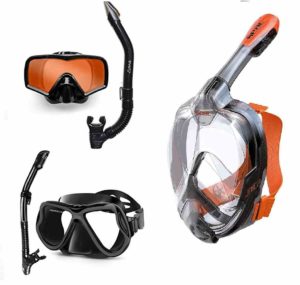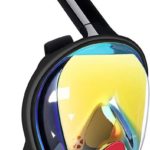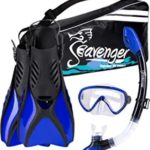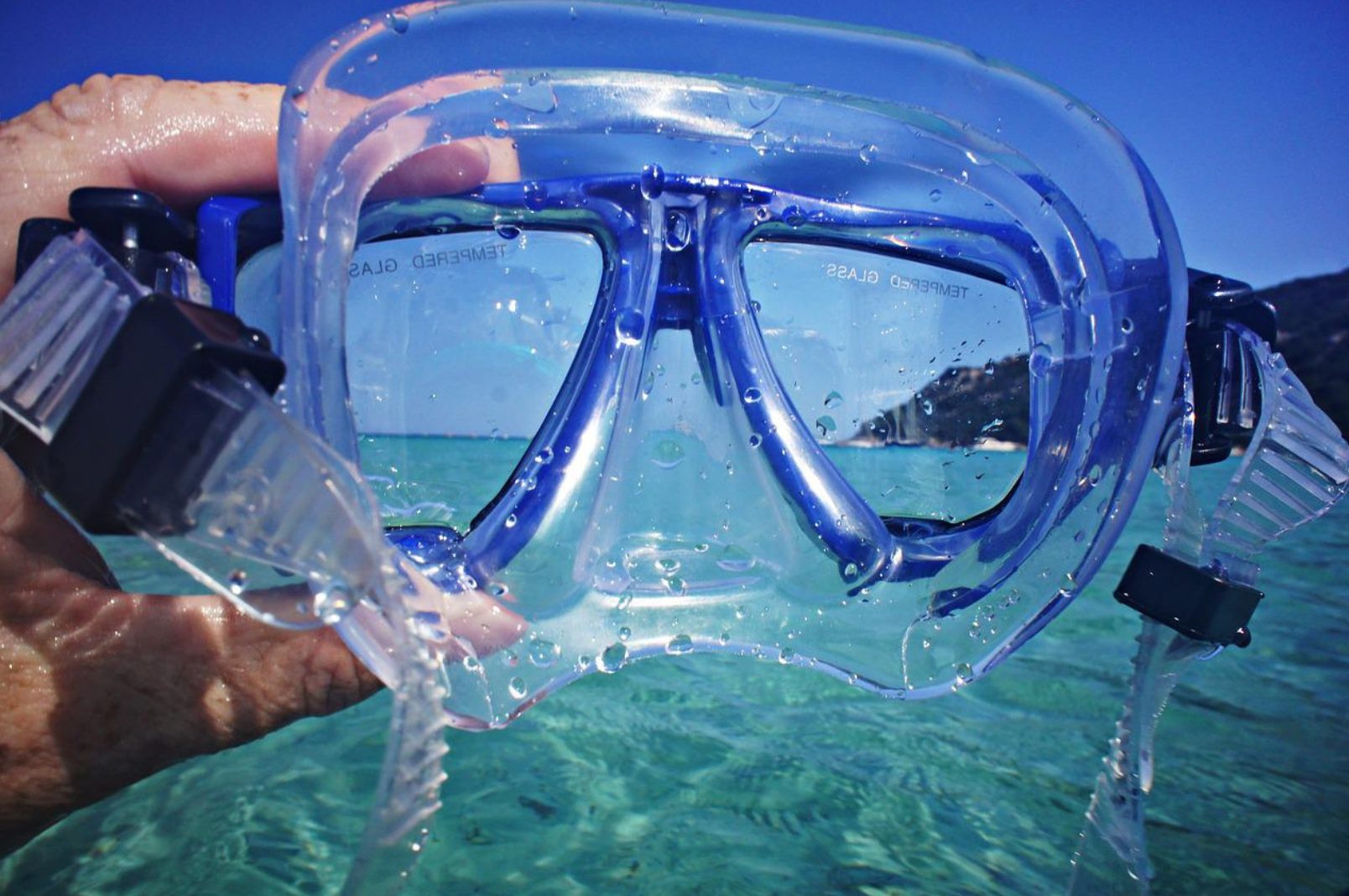What are the different types of snorkel, and how do they work?
There are three types of snorkel: classic, semi-dry, and dry. Let’s see the difference among the different types of snorkel. For beginners or younger snorkelers, it’s very important to know the different types of snorkels and their work so they can choose the right snorkel for their selves.
Dry snorkel for kids:
I recommended that beginners’ kids snorkelers start snorkeling with a dry snorkel. The factors behind this logic are very simple and comprehensive. Dry-top snorkel has a splash guard at the top of the dry snorkel, which stops the water from getting inside the tube. A dry snorkel allows kids easy and smooth breathing.
Semi-dry snorkel for kids:
When you have some experience in snorkeling and can dive through the deep water, you can snorkel with a semi-dry snorkel.
Difference between semi-dry snorkels Vs. Dry Snorkel
When you want to begin snorkeling and fulfill your passion for snorkeling, you get information about snorkels. Many kids and beginners’ snorkels love to begin snorkeling with the dry snorkel. Do you know why this happens? The difference between semi-dry and dry snorkel is quite small, but there is a difference between dry top and mouthpiece.
A dry snorkel has a float valve in the tube, which seals the snorkel tube when it is completely submerged. This condition happens when taking a long dive or a heavy wave rolls over you. A semi-dry snorkel has a splash guard at the top of the snorkel, but on the other hand, a dry snorkel has both a splash guard and a dry valve at the top of the snorkel.
A dry-top snorkel has its reservoir near the mouthpiece, and a semi-dry snorkel has its reservoir found just away from the mouthpiece. The floating valve of a dry snorkel aims to prevent the water from entering the tube, and you do not need to clear the tube. Due to these factors, dry snorkels are popular among kids and beginners snorkelers.

The dry snorkel maximizes your comfort and prevents water from getting inside the tube. Newbies snorkelers have to face a common problem of breathing when they tilt their heads in such ways, which can accidentally submerge the snorkel, and they feel the water getting to their mouth from a stray wave, and this situation may be scary for you.
The invention of a dry snorkel has made snorkeling easier and accessible to many people with different abilities and levels of comfort. Thus the design of a dry snorkel is likely to be different from the traditional snorkel or semi-dry snorkel. The basic and key differences are the floating valve, comforting features, and size of the snorkeling tube.
Do you know how a dry snorkel works? Floating valve!
A valve found at the top of a dry snorkel is called a “floating valve.” The floating valve prevents the water from entering the tube when submerged. This valve works in a hinge mechanism that pushes the flap over the dry snorkel’s opening, and when the top of the snorkel is submerged, the floating mechanism will allow it to rise to close the opening.
In this way, this mechanism allows you to breathe without needing to clear it. On the other hand, a semi-dry snorkel has a simple and traditional design.
A semi-dry snorkel has no floating valve; it just has a silicone mouthpiece attached to the tube. The difference between semi-dry snorkels vs. dry snorkels is a floating valve. Semi-dry snorkel has also splash-guards, flexible tubes, and purge valves.
Do you know the comforting features of wet vs. dry snorkel?
Dry snorkels are designed and constructed for beginners, whether adults or kids. These snorkels have many key factors which increase their comfort levels, such as a flexible tube, purge valve, float valve, mouthpiece, and splash guards.
Flexible tube
Dry snorkel and semi-dry snorkel have a “j” shaped flexible tube. In contrast, some wet snorkels have this feature also. This flexible tube allows you to adjust your position and mouthpiece.
This tube also provides you with great comfort and fitting. You may also fall away from the mouthpiece when it’s not in your mouth. But in SCUBA diving, you need the mouthpiece out of your way while using the regulator.
Purge valve
The semi-dry and dry snorkel has a purge valve located in the reservoir near or below the mouthpiece; at this point, extra water can collect. The bottom of the purge valve consists of a soft silicone valve that opens when you exhale to clear the tube.
This purge valve also helps you clear the tube’s water with a little effort.
Splash –guards
All dry snorkels have a splash guard, which deals with water spray at the surface. It is a piece of extra plastic that covers the opening of the snorkel. The purpose of a splash guard is to shunt water from wave spray away from the opening.
Wet snorkel vs. dry snorkel-size
The length of the snorkel is important for enjoying a better snorkeling experience. The snorkel’s length ensures the snorkel’s opening adjusts above the water’s surface. Comparing it with the splash guard prevents the lightly turbulent water from entering the tube.
To accommodate the level and extra weight of floating valves, purge valves, and splash guards, the size of the dry snorkel keeps bulky and just wide. Long snorkels in size mean a great volume of air than the short skinning snorkels.
Avoid wearing too long snorkel because it can be dangerous to inhale at least some air you have just exhaled in each ventilation cycle. It’s not good for a snorkeler to get too much carbon dioxide and not enough oxygen to breathe. Always take long and deep breaths while snorkeling.
Which one is best for kids; wet snorkel vs. Dry Snorkel?
Our pick is dry snorkel is the best for kids compared to a wet snorkel. It’s easy to use for those kids who have trouble clearing the snorkel when filling the water in the snorkel.
A dry snorkel provides extra fitting and comfort compared to a wet one. In salty water, a dry snorkel performs better than a wet snorkel.
Plus points of wet snorkel and dry snorkel
Dry snorkel
- Strong contender of no entering water in the mouth
- No need for a clear & uninterrupted snorkeling experience
- The purge valve prevents to enter the water in the tube
- The flexible tube allows you easy and extra comfort
Wet snorkel
- Reasonable price
- Lightweight
- A very simple design makes it stronger
- Streamlined design minimizes dragging
Minus points of wet snorkel and dry snorkel
Having some plus points, both snorkels have some negative points also.
It has been noticed that the floating valve of the dry snorkel sometimes jams, and you have to face a critical situation. The wet snorkel is lightweight, but it’s tough to wear for a long time.
Dry snorkel
- High price
- Sometimes floating valve may be jam
- Feeling bulky
- Buoyant when submerged
Wet snorkel
- No purge valve
- No flexible tube
- Water clearing regularly
- Chance to get water in your mouth





